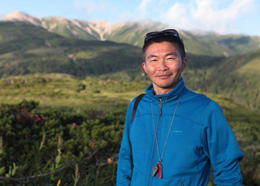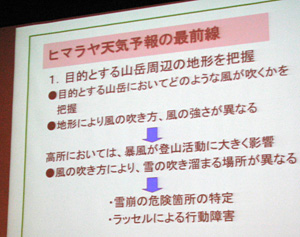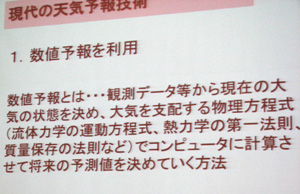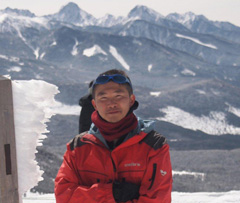Top>HAKUMON Chuo [2014 summer Issue]>Supporting the safety and peace of mind for mountaineers
 Index
Index
News&Chuo University News

Photography by Jun Hiraga
Supporting the safety and peace of mind for mountaineers
Mountain weather forecaster Takayuki Inokuma gives a lecture at Chuo University
From his location in Chino City, Nagano Prefecture, he gives weather forecasts for the summit of the distant Mount Everest. Takayuki Inokuma (43) is a mountain weather forecaster, a profession which is rare even in Japan. Inokuma climbed numerous mountains when he was a member of the Chuo University Alpine Club. Today, he serves as Director of the same club. On April 11th, Inokuma gave a lecture on the Tama Campus, sharing his emotions when he was injured and forced to give up mountaineering. His lecture was entitled “Repaying my obligation to the mountains as a mountain weather forecaster.”
A large screen had been set in the Medium-sized Auditorium of C-Square. The screen displayed the image of a mountaineering party attempting to summit the 8,848 meter peak of Mt. Everest, the tallest mountain in the world. The gleaming white of unmelted snow and jet-black mountain rocks were capped with a clear blue sky stretching as far as the eye can see.
Great Summits is a popular television program on NHK satellite broadcasting. The theme of that day’s program was the challenge of a mountaineer seeking to become the first person to carry a large high vision camera to Mount Everest’s summit and photograph the world’s highest peaks.
Six days are required to climb from the base camp to the summit. Good weather is essential during this time. On the day of reaching the summit, the weather is the greatest point of interest.
Inokuma gave a negative reply on the photography team’s initially planned date for summiting Mount Everest. A low-pressure system had appeared and the weather was deteriorating. Inokuma judged that the strong winds made a summiting attempt dangerous. The forecast called for clear skies 10 days later. The photography team avoided the danger and postponed their expedition to the summit.
Mountaineering weather forecasts are a matter of life and death. Inokuma has provided weather forecasts to more than 50 mountaineering expeditions seeking to climb peaks located overseas. He has an office at the foothills of Mount Yatsugatake and is held in high regard for the weather forecasts which he has provided to mountaineers, travel agencies, ski resorts and mountain transportation agencies.
460 steps
Inokuma was born in Murakami City, Nagano Prefecture. Due to his father’s work, he moved to Ninomiya Town, Kanagawa Prefecture as a child. Inokuma felt that the weather in the Shonan region was different from his hometown. This experience sparked his interest in meteorology, and he soon became engrossed in the field.
“When I was a high school student, I couldn’t keep up with the material in class,” recalls Inokuma. “I was a weak person who fled from everything that I disliked.”
Inokuma was a high-school graduate who had failed to enter university and was waiting for another chance. Upon entering Chuo University, he entered the Alpine Club with the goal of changing himself.

“I didn’t want my time at university to be a repeat of high school,” he explains. “In order to spend a fulfilling 4 years, I chose the Alpine Club in order to train both my mind and body.”
During the Chuo University Alpine Club’s training camp at Mt. Tanigawadake, Inokuma shouldered a pack weighing 40 kilograms and climbed the 460 steps from the underground station. He lived in tents together with other students, cooking meals, washing cooking utensils, and performing other minute tasks.
“I had a weak stomach and couldn’t eat breakfast like the other club members. I worried that my body wouldn’t allow me to keep up with the others. I thought about quitting, about running away…but if I ran away, nothing would have changed from high school. I told myself to endure for just one more day.”
The 10-day training camp tested the limits of Inokuma’s physical and mental endurance. However, upon returning home, the world around him seemed different. “I felt refreshed and had a sense of fulfillment,” he remembers.
During summer training camp, Inokuma endured a long stretch of 3 weeks. “My body was weak, but I was determined to keep up with and overtake the other club members,” he explains. “I trained more than anyone else, doing rock climbing and going for hikes in the mountains.”
The following spring, Inokuma became a 2nd-year student. The Alpine Club welcomed new members, some of whom had experience in judo and karate. “I was afraid of losing to the new members, but I was stronger than them during the training for new members. I felt that my year of training had been a success.”
In his 3rd year at university, Inokuma participated in a winter climb of Mount Fuji. He had grown confident in his physical abilities and now enjoyed mountaineering. However, as the Japanese proverb says, lights are usually followed by shadows. When crossing a stream near the summit of the Hakusandake peak on Mount Fuji, Inokuma and another club member were suddenly struck by a strong gust of wind. They fell almost 300 meters. At the time, Inokuma and his friend were separated from other club members in order to train on a route which they planned to ascend the following year.
Inokuma’s friend was suffering from serious injuries when rescued. He had broken his jaw and was unable to speak.
“I had hurt my leg and was unable to move, so I spent about 25 hours by myself in a bivouac shelter,” recalls Inokuma. “I remained still, focused on enduring the cold and pain. The blood inside of my boot had frozen and I suffered from severe frostbite.”
Serious injuries
About 30 hours passed before Inokuma was finally rescued. His diagnosis was severe—a crush fracture of his left leg. (Crush fracture: The bone cracks in multiple locations. Depending on the condition, several operations are sometimes required. Even following treatment, there are often after effects. It is one of the most serious types of broken bones.)
“I underwent 3 operations. The second operation took 10 hours. I was in danger of dying from respiratory difficulty and blood loss, so it became impossible to administer an anesthesia in the middle of the operation. The pain was intense. I felt like I was being fallen into pieces to bits in a vice. It was so bad that I wanted them to just cut off my head and end it! I would lose consciousness from the pain, only to be reawakened by the pain.”
Only two years after this gruesome operation, Inokuma was climbing the mountains again. In 1997, he quit his job at a travel agency and ascended Mt. Jomo Gangtse in Tibet (7,048 meters). “At the summit, I was brought to tears by the memories of hardships endured since the accident on Mount Fuji,” he says.

In 1999, Inokuma was struck with fulminant hepatitis and came close to losing his life. “The doctor called my parents and told us that the survival rate is only about 20% to 30%. It felt as if my cells were dying one by one.”
In 2005, Inokuma was diagnosed with a disease known as chronic osteomyelitis.
“In osteomyelitis, germs enter inside the bone and the bone rots,” he explains. “I was hospitalized 5 times during a 5-year battle with the disease. The doctor told me that a complete recovery was nearly hopeless. It was an aftereffect of my fall on Mount Fuji.”
Inokuma was forced to give up mountaineering. At work, he could only do office work.
“I enjoyed watching the weather, so I decided to become a weather forecaster. The mountains had made me a better man and I wanted to give something back. It is my hope that nature and mankind can exist together in harmony. At that time, there were no other mountain weather forecasters, so I felt like I had a good opportunity.”
One year later, Inokuma had acquired qualification as a weather forecaster. He quit his job at a travel agency and found new employment at a weather company. Then, in September 2011, he established Yamaten Co., Ltd. (Head Office: Chino City, Nagano Prefecture), Japan’s only weather company specializing in weather forecasts for the mountains.
Fortunately, Inokuma’s chronic osteomyelitis has subsided. 5 years earlier, he met with a great doctor from Teikyo University and underwent an operation. Today, he is even capable of running again. Since osteomyelitis is not specified as an intractable disease by the Japanese government, there is no public financial support. Many patients suffer from economic difficulties.
While speaking at Chuo University, Inokuma changed his grip on the microphone.
“I would like to share something with today’s students. Life is full of both good and bad things. Hardship offers a chance for success. After sufficient consideration, having the courage to take the first step forward will open up new possibilities.”
“Climbing one step upwards gives you a different view than when on the ground. Take another step upwards and the view changes yet again. Hardship and effort during youth will always bring benefit later in life. Have courage. Today, I lead a fulfilling life which I never could have imagined when I was a university student.”
●
Inokuma’s speech was met with thunderous applause. Some audience members were moved to tears. The audience left the room with renewed courage in their hearts.
Further Information

■Support for famous mountaineers
By providing weather forecasts, Inokuma supports Hirotaka Takeuchi, who became the first Japanese mountaineer to conquer all fourteen 8,000+ meter peaks with a successful climb of Nepal’s Dhaulagiri (8,167 meters) two years ago.
■Ayako Imoto
Ayako Imoto, a Japanese comedian appearing on the Nippon Television Network’s popular program Sekai No Hate Made ItteQ!, planned to ascend Mount Everest, the world’s highest peak. Inokuma was scheduled to provide meteorological support for the climb. However, Nippon Television abandoned the plan due to inadequate mountaineering preparation associated with the accidental deaths of several local guides (April 28th).
■Written Works
The Encyclopedia of Mountain Weather (Yama-Kei Publishers), Risk Management for Mountain Weather (Yama-Kei Publishers), Repaying Obligation to Mountains as a Weather Forecaster (Sangokan Publishing), etc.
- Research Activities as a Member of Research Fellowship for Young Scientists (DC1), Japan Society for the Promotion of Science (JSPS) Shuma Tsurumi
- Important Factors for Innovation in Payment Services Nobuhiko Sugiura
- Beyond the Concepts of Fellow Citizens and Foreigners— To Achieve SDGs Goal 10 “Reduce Inequality Within and Among Countries” Rika Lee
- Diary of Struggles in Cambodia Fumie Fukuoka
- How Can We Measure Learning Ability?
—Analysis of a Competency Self-Assessment Questionnaire— Yu Saito / Yoko Neha - The Making of the Movie Kirakira Megane








